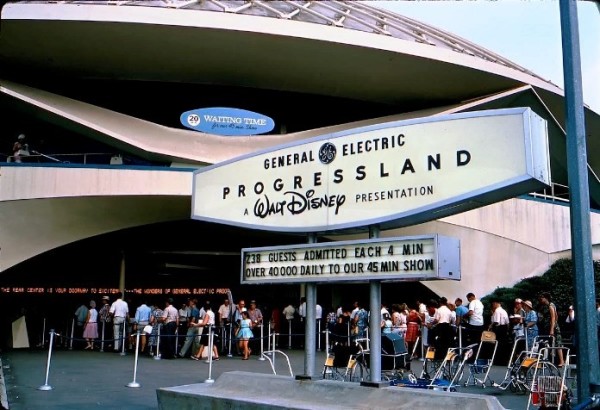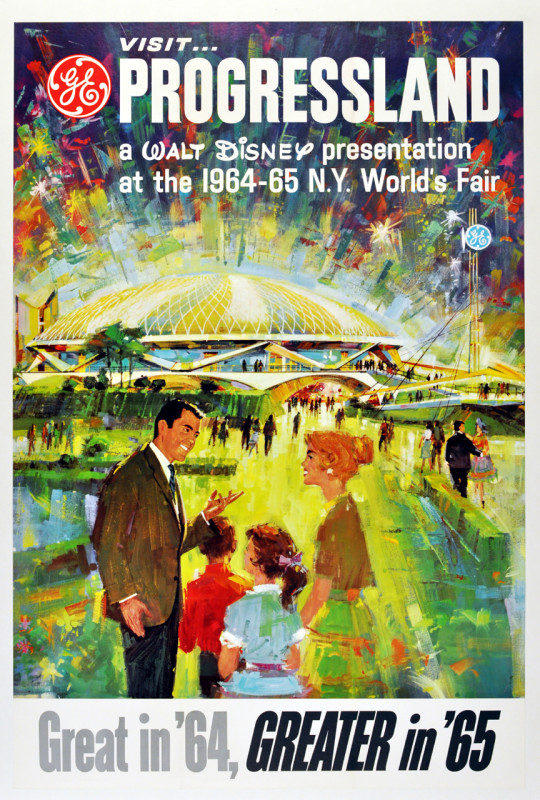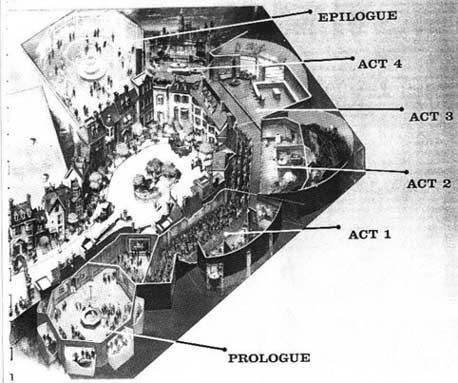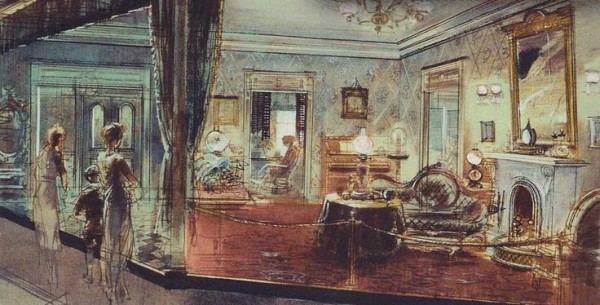‘Disneyland will never be completed. It will continue to grow as long as there is imagination left in the world.’ Despite the shaky opening day of Disneyland on July 17th, 1955, Walt’s original park was a hit. Walt would quickly began brainstorming new ideas to expand his park. By 1959 Tomorrowland received it’s first expansion, and three fan-favorite attractions opened; the Matterhorn Bobsleds, Submarine Voyage and the Disneyland Monorail. But another expansion was slated to open by the end of the 1950s, Edison Square. This new land, along with Liberty Street, was to be an expansion to Main Street U.S.A. and would take place in an American city where electric street lamps were brand new and all the rage. Edison Square was to focus on the progress and innovations of man.
In the 1950s, it was the newly formed corporation, General Electric, that approached Walt about sponsoring a new major attraction at the park. They were interested in following other major companies such as Monsanto and Pepsi and wanted a piece of prime Disneyland real estate. Talks between Disney and GE would spark the discussion of Edison Square which would feature the centrepiece attraction The Carousel of Progress. It would be a show of several scenes depicting the achievements in technology; guests would walk from scene to scene….wait what?! Yes, walk. If you look closely at early sketches, behind the facades of buildings in Edison Square, there would be several stages. Guests would enter through one building from the street and walk from scene to scene. This amount of walking for parks guests was not appealing. Imagineers, such as Bob Gurr, then developed an idea for a rotating theatre, but the technology simply was not there in the late 1950s. GE was not happy with the idea and Walt was frustrated by the technical limitations for his dream show. So the idea was scrapped, and both parties parted ways, in hopes to rekindle the flame of their relationship in the future.
By the early 1960s, General Electric’s reputation took a nosedive. The company was caught up in a scandal regarding price-fixing on their products. They plead guilty in federal court, and were fined nearly half a million dollars. Their public image needed help. Luckily, a group of New York businessman were considering to hold a massive world fair and exposition to both relive their youth from the 1939 New York’s World Fair and to increase tourism income in the New York area. The 1964/1965 New York World’s Fair would be a spotlight on American Industry and some corporate heavyweights were in on the action; General Motors and IBM to name a few. At the same time, the wheels inside Walt’s head were turning at the idea to get involved. Disney building attractions for the fair would be a test run for an east coast audience. Once Walt secured corporate sponsorship and funding, he could stop worrying about the finance side and focus on what he loved, the creative side. With corporate sponsors footing the bill, Walt could allow is imagination to truly soar. This would be a creative boom period for the Imagineering department. Walt produced four attractions for the fair, ‘it’s a small world’ with Pepsi’s sponsorship, Ford would sponsor the Magic Skyway and the state of Illinois was backing Great Moments with Mr. Lincoln. General Electric, in desperate need to improve their image, would finance Walt’s fourth project, Progressland, featuring The Carousel of Progress. GE was keen to build an entire exhibit around the idea of progress and moving forward and moving away from their negative publicity. Progressland was a 200 foot wide mid-century modern dome building, designed by Welton Becket & Associates. The dome was illuminated and featured a spiral web. It was sleek and futuristic and the crowds loved it. The building had three levels. Guest would ascend a ramp first to the middle level, where the Carousel of Progress theatre was located. Then move upwards into the dome section for the Sky Dome Spectacular to finally descend again to the ground level.
The main show and theatre had six acts following the same family, or generations of the family, through significant improvements in technology to their home. The carousel theatre would have six separate theatres and would rotate around a stationary stage. A complete setup reversal to the Edison Square version. Act I was the loading point and was an introduction while guests would gaze onto a kaleidoscopic glass mural. Act II was when guests first met the family, including Father voiced by actor Rex Allen. This first scene was set in spring time, somewhere in the 1890s, where the family had gas lamps and a telephone. Act III would move into summer of the 1920s. Wires are strung everywhere in the house, and the radio was the new family favorite. Next was the fabulous 1940s and father tells us about super highways, the rat race and his new electric dishwasher. Act V was the present, or 1964, around Christmas time. The family show off their Christmas presents, which happen to be the the latest line of products by General Electric. In the sixth and final act, the theatre rotated into the sixth space and instead of a stage, guests were met with a speed ramp that would ascend into the dome and post show.
By the mid 1960s, the technology that Walt and the Imagineers needed to achieve their goal was finally somewhat there. That’s not to say that designing the attraction was easy. Harriet Burns was responsible for taking Marty Sklar’s original sketches and constructing a scale model of each scene. She poured every once of energy into making that model, and did not leave any detail out. From a tiny toothbrush by the sink, to the small print on the newspaper being read by father. GE executives said, ‘If the real thing is as beautiful as this, it will be a sensation.’ GE was happy with Walt’s progress report, but hurdles still had to be jumped. The Sherman brothers, would be given the task to write the theme song to The Carousel of Progress. The boys were very busy during this period. They were finishing up Mary Poppins, began work on Winnie the Pooh and would soon start working on the score for The Jungle Book. They knew that Walt was working on some attractions for the fair, and that dozens of artists were hard at work. But they thought nothing of it, they had film scores to write. But as Richard put it, they ‘walked backwards’ into writing the hit song ‘There’s a Great Big Beautiful Tomorrow’. The had to create the foot that would snuggly fit into the shoe of an already established attraction. Walt gave specific guidelines; the song had to be 40 to 45 seconds long. It had to be mouldable and be played in various styles such as ragtime, jazz and swing to match the various scenes. ‘When Walt has a dream, we all have to fall in line with it.’ Richard Sherman said. The brothers created one of the most memorable songs in Disney history. It was a song about Walt, and reflected his optimism and enthusiastic view of the future.
The work didn’t stop there. Imagineers had to now create a new animatronic that they hadn’t achieved yet. An animatronic figure of a human. Up until this point, the animatronics were mainly animals or based on animated characters. Building a figure to look and breath like a human had to be believable. The developments of Great Moments with Mr. Lincoln would help develop the figures used for Carousel of Progress. The most challenging aspect, was how the movements would be recorded. The demonstration we all remember from Walt’s tv show were misleading. Walt had an Imagineer strapped to a harness and seated next to the stage with the figure of father from the show. Walt claimed, that the movements would be acted out by the imagineer and then recorded. Bob Gurr later confirmed, that this method did not work. A console was built with dozens of knobs, each one controlling a specific single joint on the figure. Imagineers would discover that they would have to control and set the individual movement of each joint when it was recorded. All the individual movements would play back in synchronicity. It would take hours to do, but it was the only way to get the job done.
In the end, all the pieces of the puzzle came together and Progressland had it’s grand opening on the first day of the fair on April 22nd 1964. It was a smash. Despite the attraction having a high hourly capacity, about 3,400 guests per hour, there were still long lines to experience the exciting new attraction. Guests would say it was the most exciting look into the future, which was ironic. Walt’s show was really a story about turning back the clock and looking back at history before moving forward. It was the balance of a narrative looking at history, mixed with fascinating new technology with audio-animatronics and a rotating theatre that captured the imagination of thousands of people. But the Carousel of Progress theatre would have a journey of it’s own before heading to Florida. Tomorrow I will talk more about how the show packed up and moved to California before circling back to the east coast in central Florida.









